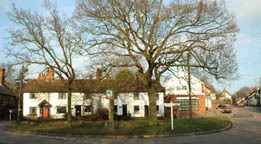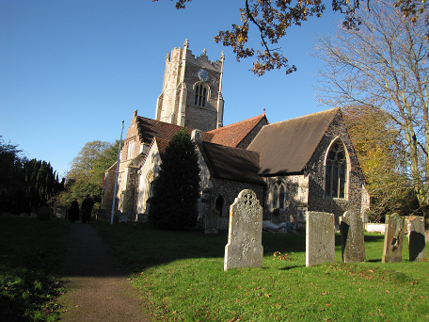Great Yeldham Today
Great Yeldham is a medium sized village of 1,949 residents (2021 Census) accommodated in 748 dwellings. It sits on the junction of the busy A1017 from Braintree to Haverhill (or from Felixstowe to Cambridge) with minor roads to Halstead and Sudbury.
The village boasts a Post Office and village store; a small Supermarket; two fast food take-away outlets; a Veterinary Surgery; an outreach Doctors’ Surgery; a hairdressers and three Public Houses.
St. Andrews Primary School in Church Road and The Acorns Pre-School housed on the same site, offer a first class introduction to education. At eleven, children progress to Secondary School and Buses are laid on in the mornings and afternoons to relay children to and from the most popular secondary school in Sible Hedingham.

Bus services run regularly from Great Yeldham to Braintree, Colchester, Halstead and Sudbury, calling at many smaller villages en route. Buses pick up by the Village Green. The railway station at Braintree, thirty minutes away by road, offers trains direct to London Liverpool Street.
There are a number of open spaces within the village including The Village Green, Whitlock Green and the Sports and Recreation Ground (with access from Toppesfield Road or via the footpath next to the old Police Station). A recreational area with swings, slide, roundabout, etc. is situated in a corner of Bowtells Meadow off Churchfields, with a skateboard park and BMX track at the Sports and Recreation Ground.
A number of Clubs and Societies exist within the village, all of which welcome new Members. (See Clubs)
Great Yeldham is surrounded by farmland, mostly arable in nature with the occasional field of sheep or cows. The many footpaths give quick access to the countryside and are linked to form the Great Yeldham Millennium Circular Walk. (See Footpath Walking Group under Clubs)
Shops, farms and the two small industrial areas at Woodpecker Court and the Hunnable Estate offer limited employment opportunities with most residents travelling out of the village for work.
A Brief History of Great Yeldham
The name “Yeldham” is a corruption of “Geldham” recorded in the Domesday Book of 1086. The latter comes from the Saxon ‘ham’ meaning Homestead and ‘Geld” denoting a tax, hence Geldham – a settlement paying a certain tax.
The Old Oak tree which stands where the three roads converge, is shown on a map of 1777 but was growing there many centuries before that. It is said that the tree was over 1,000 years old at its demise although this may be an exaggeration! Only the old stump, now filled with concrete, survives as testament to its great girth. The oak tree behind the stump was planted there over 150 years ago but has much growing still to do if it is to compete with the original tree.
Four hundred years ago the main employment for the people of Great Yeldham was on the land nurturing both crops and animals. Today, the farming is mainly arable and the use of large, modern machinery obviates the need for many farm hands. In the seventeenth Century most of the women and children in the village were employed making straw plaits for hats and bonnets.

The Whitlock family had a great influence on life in Great Yeldham when two of the brothers started the Whitlock Bros. factory, the frontage of which spanned the area now known as Whitlock Green. This factory manufactured agricultural machinery as well as acting as Dealers and exporters of their own and similar products. The Company was bought by the London and Midland Industrial Group in 1967 and finally closed its doors in 1972. At its height, the company had employed almost 600 people. The Whitlock Chaff Company exported hay to South Africa during the Boer War and at one time had 70 employees. The brick works, using locally dug clay and situated in Toppesfield Road, provided the bricks for the Chaff Works. This building can still be seen at Poole Farm today.
For over one hundred years, from 1862 to 1964, Great Yeldham could boast a Railway Station on the Colne Valley and Halstead railway line which was used to great advantage by the Whitlock enterprises, by passengers and, during the 2nd World War, transported troops and munitions for the Ridgewell Airfield where 381st Bomber Command was stationed. Now only the crumbling platforms remain with access via a footpath leading from Toppesfield Road, formally Station Road, to the Sports Field.
At one time a toll was charged to people using the road through Great Yeldham and the toll house remains on the A1017 leading out of the village to Sible Hedingham.
Many old buildings remain to grace Great Yeldham: St. Andrew’s Church begun in the fourteenth century with many additions since then; The Old Rectory (15th Century); Great Yeldham Hall built in the reign of King John; The White Hart Public House (1500) to name but a few. Spencers, on the outskirts of the village, was built in 1760 by Lady Anne Bateman nee Spencer with funds provided by her grandfather, John Churchill first Duke of Marlborough.
Recommended reading:
“A History of Great Yeldham” by Adrian Corder-Birch, ISBN 0 9513106 9 0, obtainable from
Mr. Corder-Birch by post at Rustlings, Howe Drive, Halstead CO9 2QL. Price: £6.95 + p&p.


